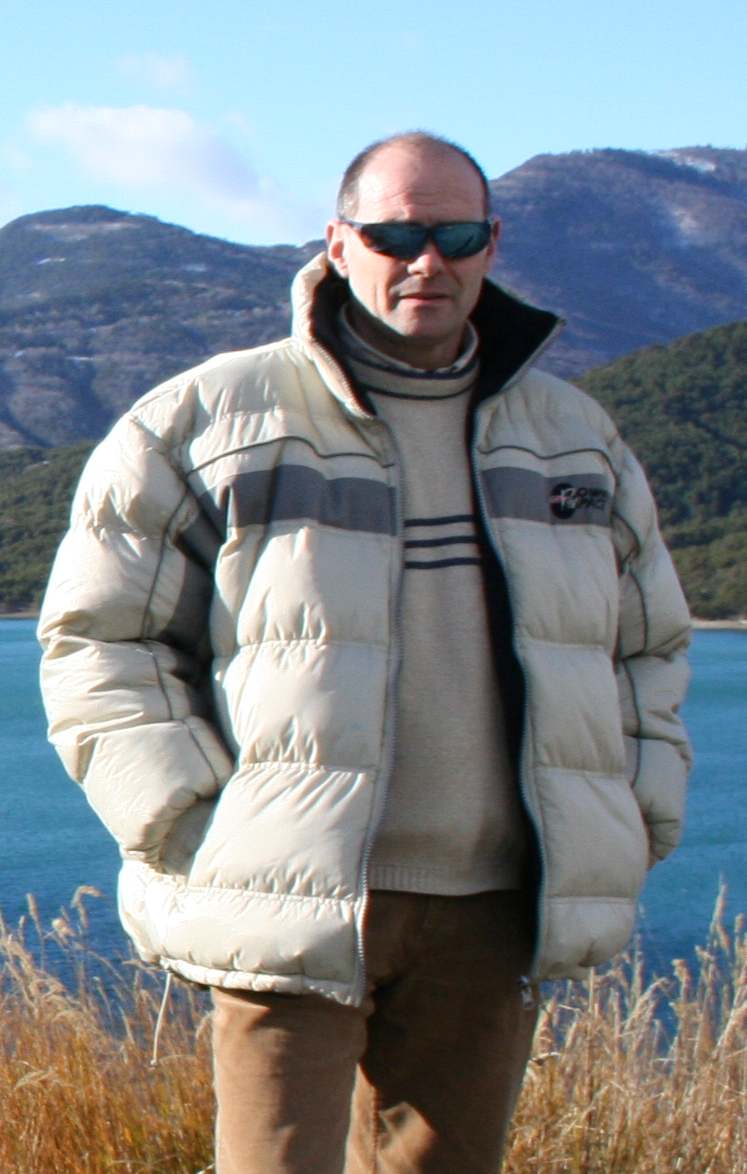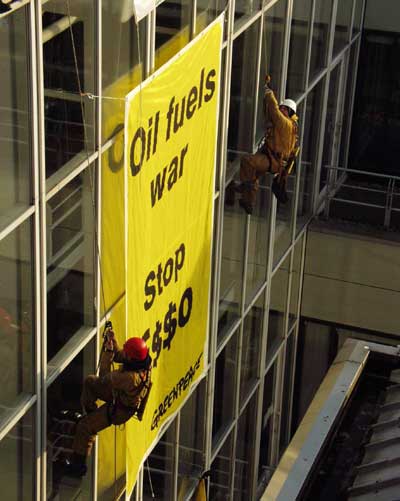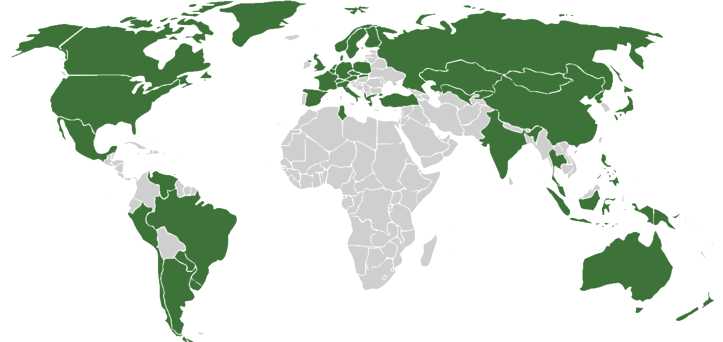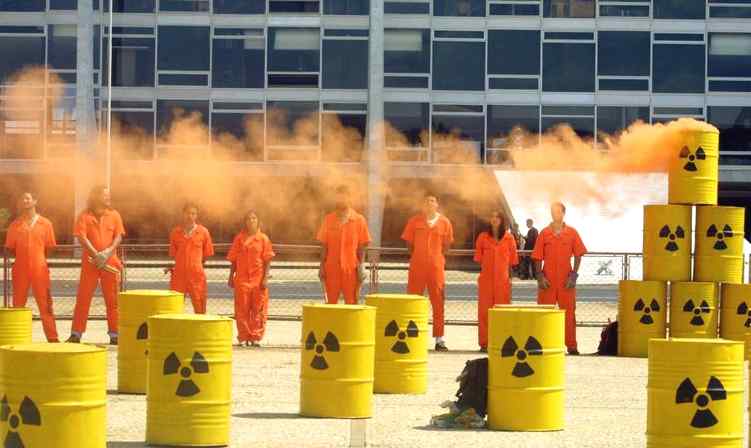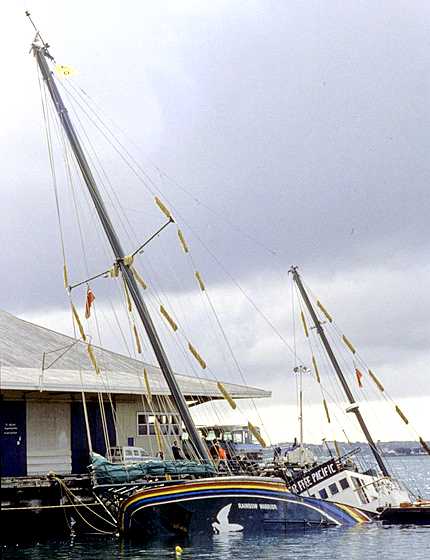|
|
||||||||||||||||||||||||||||||||||||||||||||||||||||||||||||||||||||||||||||||||||||||||||||||||||||||||||||||||||
|
HOME | BIOLOGY | BOOKS | FILMS | GEOGRAPHY | HISTORY | INDEX | INVESTORS | MUSIC | NEWS | SOLAR BOATS | SPORT |
||||||||||||||||||||||||||||||||||||||||||||||||||||||||||||||||||||||||||||||||||||||||||||||||||||||||||||||||||
|
Greenpeace are a proactive group working hard to draw attention to serious environmental issues, which views I share in broad terms. We all have our way of contributing to society, mine is to try to do something to show world leaders and future generations that alternative energy can be practical. I'm doing this by building a solar powered boat featured elsewhere on this website, with which I hope to circumnavigate the globe. The Solar Navigator uses existing technology to achieve clean transport today. If we were to use the same technology today for our homes and factories we could call a halt to global warming.
Nelson Kruschandl - well done chaps!
I am a firm believer in fair treatment, fair trade and equal opportunities. I'm also an engineer and an environmentalist, a strange combination I know. I think we should adopt a common sense approach to energy reserves, where the constant fighting to take control of oil and other natural resources, and the power struggles by different political groups, is wasteful and simply throwing human effort and lives away. Once energy is available to all at sensible cost, we will have taken a giant step toward global peace.
For all the above reasons I applaud the sterling efforts of all those who work for Greenpeace, for they are working for our precious blue planet and all those who inhabit it. NK
Greenpeace is an international environmental organization founded in Vancouver, British Columbia, Canada in 1971. It is best known for its campaigns against nuclear weapons and campaigning against whaling. In later years, the focus of the organization turned to other environmental issues, including bottom trawling, global warming, ancient forest destruction, nuclear power, and genetic engineering. Greenpeace has national and regional offices in 42 countries worldwide, all of which are affiliated to the Amsterdam-based Greenpeace International. The global organization receives its income through the individual contributions of an estimated 2.8 million financial supporters, as well as from grants from charitable foundations, but does not accept funding from governments or corporations. It is often the subject of criticism and ridicule for supposedly over-the-top protesting.
Greenpeace's protest: Esso, Exxon and Mobil
Mission statement
Greenpeace's official mission statement describes the organization and its aims thus:
Structure
Greenpeace is a global environmental organisation, consisting of Greenpeace International (Stichting Greenpeace Council) in Amsterdam, and 27 national and regional offices around the world, providing a presence in 41 countries. These national and regional offices are largely autonomous in carrying out jointly agreed global campaign strategies within the local context they operate in, and in seeking the necessary financial support from donors to fund this work. National and regional offices support a network of volunteer-run local groups. Local groups participate in campaigns in their area, and mobilise for larger protests and activities elsewhere. Millions of supporters who are not organised into local groups support Greenpeace by making financial donations and participating in campaigns as citizens and consumers.
Greenpeace's national offices world map
National and regional offices
Greenpeace is present in the following countries and regions, as of March 2007:
Argentina, Australia-Pacific region (Australia, Fiji, Papua New-Guinea, Solomon Islands), Belgium, Brazil, Canada, Chile, China, Czech Republic, France, Germany, Greenpeace Nordic (Denmark, Finland, Norway, Sweden), Greece, Greenpeace Central and Eastern Europe (Austria, Hungary, Slovak Republic, Poland, Romania, Bulgaria, Slovenia, Serbia, Montenegro and Bosnia (no permanent campaign presence in the latter five states)) India, Italy, Japan, Luxembourg, Greenpeace Mediterranean (Israel, Cyprus, Lebanon, Malta, Tunisia, Turkey), Mexico, the Netherlands, Greenpeace Aotearoa New Zealand (New Zealand), Russia, South -East Asia (Philippines, Indonesia, Thailand), Spain, Switzerland, United Kingdom, and the United States.
Priorities and campaigns
Greenpeace runs campaigns and projects which fit into the "Issues" (as campaign areas are called within Greenpeace) categories below. Besides exposing problems such as over-fishing or threats linked to nuclear energy such as harmful radiation and proliferation, Greenpeace campaigns for alternative solutions such as marine reserves and renewable energy.
The organisation currently addresses many environmental issues with a primary focus on efforts to stop global warming and the preservation of the world's oceans and ancient forests. In addition to conventional environmental organisation methods, such as lobbying businesses and politicians, and participating in international conferences, Greenpeace uses nonviolent direct action in many of its campaigns.
Greenpeace uses direct action to attract attention to particular environmental problems. For example, activists place themselves between the whaler's harpoon and their prey, or invade nuclear facilities dressed as barrels of radioactive waste. Other initiatives include the development of a fuel-efficient car, the SmILE.
Current priorities
Below is a list of Greenpeace's current priorities, as of March 2007:
History
Origins
The origins of Greenpeace lie in the Peace movement and the Campaign for Nuclear Disarmament generally and particularly in the Don't Make A Wave Committee co-founded by Jim and Marie Bohlen and formed by an assortment of Canadian and expatriate American peace activists in Vancouver in 1970. Taking its name from a slogan used during protests against United States nuclear testing in late 1969, the Committee had come together with the objective of stopping a U.S. nuclear bomb test codenamed Cannikin beneath the Aleutian island of Amchitka, Alaska.
Many of the founding members were members of the Society of Friends. The committee was affiliated with the Sierra Club but it withdrew its support when Jim Bohlen, a member of the committee, told journalists that the committee would send a boat to Amchitka to protest the nuclear test without it having been approved by the Sierra Club.
The first ship expedition, inspired by the voyages of the Golden Rule, Phoenix and Everyman in 1958, was on the chartered trawler, Phyllis McCormack, was called the Greenpeace I; the second expedition was nicknamed Greenpeace Too!. The test was not prevented, but the voyage laid the groundwork for Greenpeace's later activities.
Greenpeace protest in Brasília, Brazil
Early influential people
Bill Darnell has received the credit for combining the words "green" and "peace", thereby giving the organization its future name. Irving Stowe a member of the Society of Friends can probably be described as the father of Greenpeace and introduced the concepts of nonviolence and bearing witness. Robert Hunter was a media guru and spiritual and organisational leader. Ben Metcalfe became the first Chairman of the Greenpeace Foundation and with wife Dorothy managed the media for the first few years. Dr Patrick Moore was the ecologist of note and served for nine years as President of Greenpeace Canada, as well as seven years as a Director of Greenpeace International. Rod Marining's campaign saved the entrance to Vancouver's Stanley Park, he was on the first voyage to Amchitka and was a board member during the 1970's. Paul Watson was involved in the very early days of Greenpeace, but later founded Sea Shepherd and sank the whaler Sierra in 1979. Lyle Thurston was medical doctor on the first voyage and served on the board during the 1970s.
Campaigns
On 4 May 1972, following Dorothy Stowe's departure from the chairmanship of the Don't Make A Wave Committee, the fledgling environmental group officially changed its name to the "Greenpeace Foundation".
In 1972 the yacht Vega a 12.5-metre ketch owned by David McTaggart, (an eventual spokesman for Greenpeace International 1979-1991), was renamed Greenpeace III and sailed in an anti nuclear protest into the exclusion zone at Mururoa in French Polynesia to attempt to disrupt French atmospheric nuclear testing. This voyage was sponsored and organised by the New Zealand branch of the Campaign for Nuclear Disarmament. CNDNZ and the NZ Peace media had been lobying the New Zealand Government and the New Zealand public to place pressure on Britain and France to agree to enforce a nuclear test ban in the South Pacific since the mid 1950s. This pressure through civil disobedience protests in French Polynesia and public education at home, eventually resulted in New Zealand declaring itself a nuclear-free zone by legislation in 1987. (New Zealand Nuclear Free Zone, Disarmament, and Arms Control Act 1987). In 1974 La Flor, from Melbourne, Australia, skippered by Rolf Heimann, a childrens' author set out for Mururoa via New Zealand as Greenpeace IV but arrived after the final nuclear test for the year. The French Military conducted more than 200 nuclear tests, (40 of them atmospheric), at Mururoa and Fangataufa atolls over a thirty year period ending 1996.
In
1974 the Vancouver based Greenpeace Foundation mounted an anti-whaling
campaign that encountered Soviet whalers over the Seamounts off Mendocino,
California. This campaign had been influenced by the work of Paul Spong and
Farley Mowat and Robert Hunter's encounter with the Orca
Skana.
In 1976 a campaign was launched against the killing and skinning of seal pups in Newfoundland for the high fashion fur trade, targeting Norwegian ships engaged in the trade after receiving a hostile welcome from the Newfie fishermen involved in the hunt. Greenpeace used helicopters to move people and supplies to a base camp at Belle Isle. Brigitte Bardot later involved herself in this campaign to great effect. In the same year a another anti-whaling expedition using the James Bay as Greenpeace VII disrupted the Soviet fleet again, but this time with the assistance of a "deep throat" source and extra funding from Ed Daly of World Airways. At about the same time visits to Japan were arranged to persuade the Japanese people that whaling should be ended.
By the late 1970s, spurred by the global reach of what Robert Hunter called "mind bombs", in which images of confrontation on the high seas converted diffuse and complex issues into considerably more media-friendly David versus Goliath-style narratives, more than 20 groups across North America, Europe, New Zealand and Australia had adopted the name "Greenpeace".
Greenpeace also engaged with their opponents through the courts both in Canada (defending a loitering charge for failing to leave a fisheries office) and in France (David McTaggart's Law of the Sea case to recover repair costs after his yacht Vega was damaged by the French navy).
Similarly, Greenpeace became involved with lobbying elected officials and various bodies such as the United Nations through events such as the Conference on the Human Environment and with the International Whaling Commission.
Formation of formal global organisation
In 1979, however, the original Vancouver-based Greenpeace Foundation encountered financial difficulties, and disputes between offices over fund-raising and organisational direction split the global movement. David McTaggart lobbied the Canadian Greenpeace Foundation to accept a new structure which would bring the scattered Greenpeace offices under the auspices of a single global organisation, and on October 14, 1979, Greenpeace International came into existence. Under the new structure, the local offices would contribute a percentage of their income to the international organisation, which would take responsibility for setting the overall direction of the movement.
Greenpeace's transformation from a loose international network to a global organisation enabled it to apply the full force of its resources to a small number of environmental issues deemed of global significance, owed much to McTaggart's personal vision. McTaggart summed up his approach in a 1994 memo: "No campaign should be begun without clear goals; no campaign should be begun unless there is a possibility that it can be won; no campaign should be begun unless you intend to finish it off". McTaggart's own assessment of what could and couldn't be won, and how, frequently caused controversy.
In re-shaping Greenpeace as a centrally coordinated, hierarchical organisation, McTaggart went against the anti-authoritarian ethos that prevailed in other environmental organisations that came of age in the 1970s. While this pragmatic structure granted Greenpeace the persistence and narrow focus necessary to match forces with government and industry, it would lead to the recurrent criticism that Greenpeace had adopted the same methods of governance as its chief foes — the multinational corporations. Its current Executive Director is Gerd Leipold.
For smaller actions, and continuous local promotion and activism, Greenpeace has networks of active supporters that coordinate their efforts through national offices. The United Kingdom has some 6,000 Greenpeace activists.
30th Anniversary
In celebration of the 30th anniversary of its founding, Greenpeace presented a photohistory of its achievements from 1971 to 2001.
Greenpeace ships
Since Greenpeace was founded, seagoing ships have played a vital role in its campaigns.
In 1978, Greenpeace launched the original Rainbow Warrior, a 40-metre, former fishing trawler named for the Cree legend that inspired early activist Robert Hunter on the first voyage to Amchitka. Greenpeace purchased the Rainbow Warrior (originally launched as the Sir William Hardy in 1955) at a cost of £40,000, and volunteers restored and refitted her over a period of four months.
First deployed to disrupt the hunt of the Icelandic whaling fleet, the Rainbow Warrior would quickly become a mainstay of Greenpeace campaigns. Between 1978 and 1985, crew members also engaged in non-violent direct action against the ocean-dumping of toxic and radioactive waste, the Grey Seal hunt in Orkney and nuclear testing in the Pacific. Japan's Fisheries Agency has labeled Greenpeace ships as "anti-whaling vessels" and "environmental terrorists".
Rainbow Warrior, Auckland Harbour 1985.
In 1985, the Rainbow Warrior entered into the waters surrounding Moruroa atoll, site of French nuclear testing. The French government secretly bombed the ship in a New Zealand harbour on orders from François Mitterrand himself; killing Dutch freelance photographer Fernando Pereira, who thought it was safe to enter the boat to get his photographic material after a first small explosion, but drowned as a result of a second, larger explosion. The attack was a public relations disaster for France, after it was quickly exposed by the New Zealand police. The French Government in 1987 agreed to pay New Zealand compensation of NZ$13 million and formally apologised for the bombing. (Also see Sinking of the Rainbow Warrior.) The French Government also paid 2.3 Million French Francs compensation to the family of the killed photographer.
In 1989 Greenpeace commissioned a replacement vessel, also named the Rainbow Warrior, which remains in service today as the flagship of the Greenpeace fleet.
In 1996 the Greenpeace vessel MV Sirius was detained by Dutch police while protesting the import of genetically modified soybeans due to the violation of a temporary sailing prohibition, which was implemented because the Sirius prevented their unloading. The ship, but not the captain, was released a half hour later.
In 2005 the Rainbow Warrior II ran aground on and damaged the Tubbataha Reef in the Philippines, while she was on a mission to protect the very same reef. Greenpeace was fined $7,000 USD for damaging the reef and agreed to pay the fine, although they said that the Philippines government had given them outdated charts.
Along with the Rainbow Warrior the Greenpeace organisation has four other ships:
Contact details for Greenpeace UK
By
post: Greenpeace,
Canonbury Villas, London, N1 2PN By phone or fax: Tel: 020 7865 8100 Fax: 020 7865 8200
By
email:
info@uk.greenpeace.org Greenpeace is an international organisation lobbying and campaigning for peace and protection of our environment, independently of any one Government or State.
The reasonable man adapts himself to the world; the unreasonable man persists in trying to adapt the world to himself. Therefore, all progress depends on the unreasonable man. -- George Bernard Shaw
LINKS and REFERENCE
New energy drinks for performers .. Thirst for Life
330ml Earth can - the World in Your Hands
|
||||||||||||||||||||||||||||||||||||||||||||||||||||||||||||||||||||||||||||||||||||||||||||||||||||||||||||||||||
|
This website is Copyright © 1999 & 2012 Electrick Publications. The bird logos and name Solar Navigator are trademarks. All rights reserved. Max Energy Limited is an educational charity working hard for world peace. |
||||||||||||||||||||||||||||||||||||||||||||||||||||||||||||||||||||||||||||||||||||||||||||||||||||||||||||||||||
|
AUTOMOTIVE | BLUEPLANET | ELECTRIC CARS | ELECTRIC CYCLES | SOLAR CARS | SOLARNAVIGATOR | UTOPIA |
